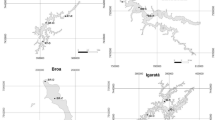Synopsis
We tested the hypothesis that the mechanism of retention of tomcod, Microgadus tomcod, larvae and juveniles in the well-mixed part of the St. Lawrence Estuary is similar to that of sympatric smelt, Osmerus mordax, larvae who actively migrate to the surface during flood tides and to the bottom during ebb tides so as to minimize net downstream displacement. The vertical distribution of tomcod larvae and juveniles was documented during two 98-h sampling series at 2 anchor stations in June and July, 1986. An hourly index of the center of mass of fish in the water column calculated to take into account daytime net avoidance in surface waters suggested that tomcod remained deep in the water column and that their accumulation at the head of the estuary was the result of passive upstream transport by net residual circulation rather than active tidal migrations. For both series, depth of fish was inversely related to density of the water suggesting that the buoyancy of fish influenced their vertical distribution. Tomcod larvae and juveniles were advected by tidal currents. In June, larger larvae were found at low slack water indicating that they were located upstream of smaller larvae. In July, larger juveniles were located downstream of smaller juveniles, the difference in mean length between low and high slack water attaining 20 mm. Ontogenetic buoyancy changes may be responsible for these differences in the vertical distribution of tomcod. Comparisons of the early life-history stages of tomcod and smelt retained in the same area under the same hydrodynamical conditions indicate that more than one mechanism permits retention in a well-mixed estuary and that the observed species-specific patterns of vertical distribution are not simply interpretable as adaptations to retention.
Similar content being viewed by others
References cited
Able, K.W. 1978. Ichthyoplankton of the St. Lawrence Estuary: composition, distribution, and abundance. J. Fish. Res. Board Can. 35: 1518–1531
Blake, R.W. 1983. Fish locomotion. Cambridge University Press, Cambridge. 208 pp
Blaxter, J.H.S. & K.F. Ehrlich. 1974. Changes in behaviour during starvation of herring and plaice larvae. pp. 575–588. In: J.H.S. Blaxter (ed.) The Early Life History of Fish, Springer Verlag, New York
Booth, R.A. 1967. A description of the larval stages of the tomcod, Microgadus tomcod, with comments on its spawning ecology. Ph.D. Thesis, University of Connecticut, Storrs. 53 pp
D'Anglejan, G. & E.C. Smith. 1973. Distribution, transportation and composition of suspended matter in the St. Lawrence estuary. Can. J. Earth Sci. 10: 1380–1396
Dodson, J.J., J.-C. Dauvin, R.G. Ingram & B. D'Anglejan. 1989. Abundance of larval rainbow smelt Osmerus mordax in relation to the maximum turbidity zone and associated macroplankton fauna of the Middle St. Lawrence Estuary. Estuaries 12: 66–81
De Wolf, L. 1973. On the retention of marine larvae in estuaries. Thalassia Jugosl. 10: 415–124
Dunn, J.R. & A.C. Matarese.1984. Gadidae: development and relationships. pp. 283–299. In: H.G. Moser et al. (ed.) Ontogeny and Systematics of Fishes, ASIH Special Publication Number 1, Allen Press, Lawrence
El Sabh, M.I. 1988. Physical oceanography of the St. Lawrence Estuary. pp. 61–78. In: B. Kjerfve (ed.) Hydrodynamics of Estuaries, Vol. 2, Estuarine Case Studies, CRC Press, Boca Raton
Fortier, L. & W.C. Leggett. 1982. Fickian transport and the dispersal of fish larvae in estuaries. Can. J. Fish. Aquat. Sci. 39: 1150–1163
Fortier, L. & W.C. Leggett. 1983. Vertical migrations and transport of larval fish in a partially mixed estuary. Can. J. Fish. Aquat. Sci. 40: 1543–1555
Frank, K.T. & J.E. Carscadden. 1989. Factors affecting recruitment variability of capelin (Mallotus villosus) in the Northwest Atlantic. J. Cons. int. Explor. Mer. 45: 146–164
Henri, M., J.J. Dodson & H. Powles. 1985. Spatial configurations of young herring (Clupea harengus harengus) larvae in the St. Lawrence Estuary: importance of biological and physical factors. Can. J. Fish. Aquat. Sci. 42: 91–104
Laprise, R. & J.J. Dodson. 1989a. Ontogeny and importance of tidal vertical migrations in the retention of larval smelt Osmerus mordax in a well-mixed estuary. Mar. Ecol. Prog. Ser. 55: 101–111
Laprise, R. & J.J. Dodson. 1989b. Ontogenetic changes in the longitudinal distribution of two species of larval fish in a turbid well-mixed estuary. J. Fish Biol. 35: (Supplement A): 39–47
Legendre, L. & P. Legendre.1984. Ecologie numérique. Vol. 2: La structure des données écologiques. 2nd edn. Masson & Presses de l'Université du Québec, Québec. 254 pp
Markle, D.F. 1984. Phosphate buffered formalin for long term preservation of formalin fixed ichthyoplankton. Copeia 1984: 525–528
Neu, H.J.A. 1970. A study on mixing and circulation in the St. Lawrence Estuary up to 1964. Atlantic Oceanographic Laboratory, Bedford Institute, Report 1970–1979. 31 pp
Ouellet P. & J.J. Dodson. 1985. Dispersion and retention of anadromous rainbow smelt (Osmerus mordax) larvae in the middle estuary of the St. Lawrence River. Can. J. Fish. Aquat. Sci. 42: 332–341
Scherrer, B. 1984. Biostatistique. Gaëtan Morin éditeur, Chicoutimi. 850 pp
Sinclair, M. 1988. Marine populations: an essay on population regulation and speciation. University of Washington Press, Seattle. 252 pp
Weinstein, M.P., S.L. Weiss, R.G. Hodson & L.R. Gerry. 1980. Retention of three taxa of postlarval fishes in an intensively flushed tidal estuary, Cape Fear River, North Carolina. U.S. Fish. Bull. 78: 419–436
Author information
Authors and Affiliations
Rights and permissions
About this article
Cite this article
Laprise, R., Dodson, J.J. The mechanism of retention of pelagic tomcod, Microgadus tomcod, larvae and juveniles in the well-mixed part of the St. Lawrence Estuary. Environ Biol Fish 29, 293–302 (1990). https://doi.org/10.1007/BF00001186
Received:
Accepted:
Issue Date:
DOI: https://doi.org/10.1007/BF00001186




